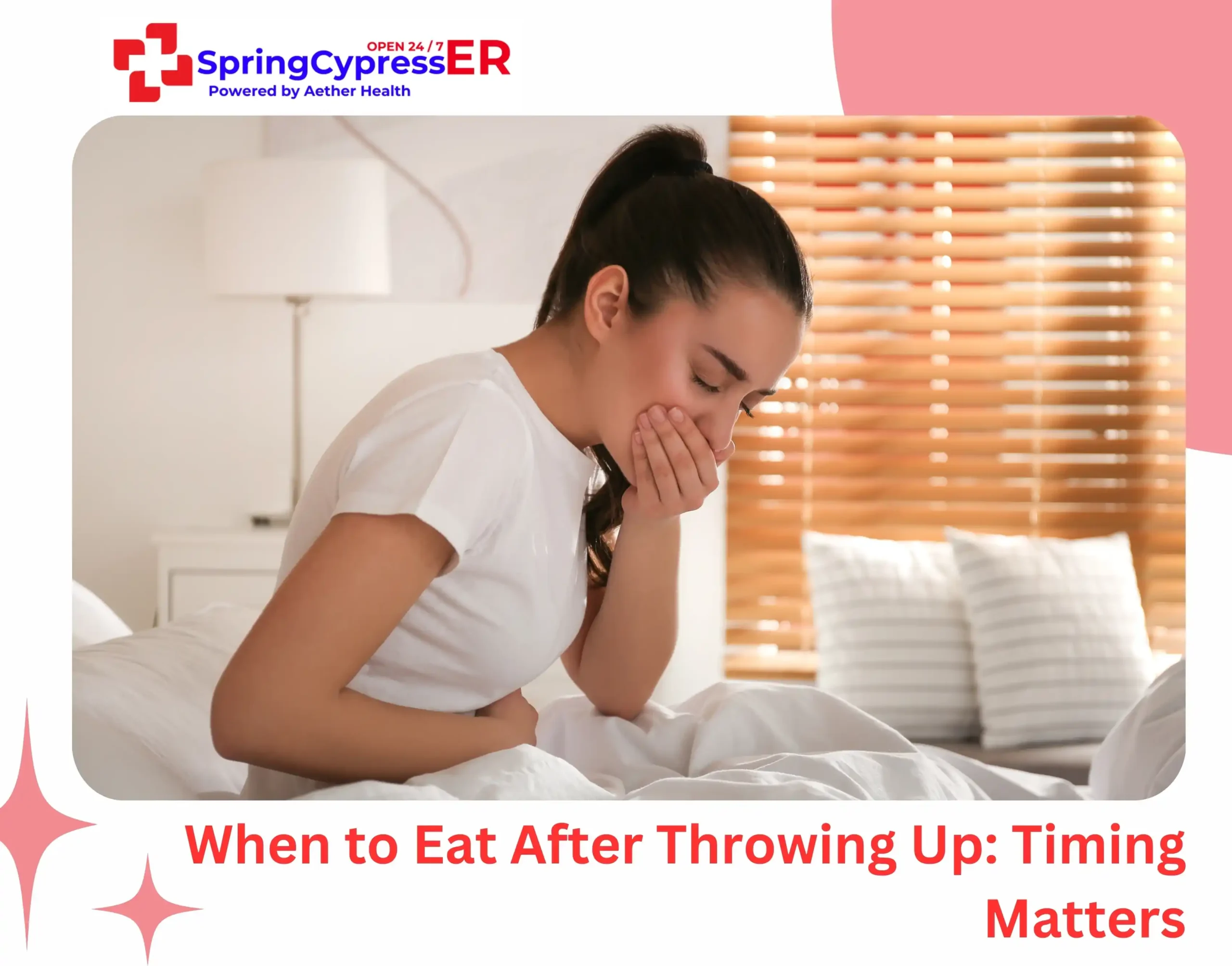Your digestive system sits in a fragile state after vomiting. It’s irritated, depleted of essential fluids and electrolytes, and hypersensitive to whatever you put in it next.
Knowing what to eat after throwing up can make the difference between a smooth recovery and another miserable round of nausea. The wrong choice sends you right back to square one, while the right easy to digest foods after throwing up help your body heal and regain strength.
Let’s explore what to eat after throwing up, when to eat them, and what to avoid so that you can get back to feeling normal.
What to Eat After Throwing Up: Your Recovery Menu

After throwing up, let your stomach rest for 30-60 minutes, then start with clear liquids like broth, soup, or ginger tea. Once liquids stay down, gradually introduce bland foods like bananas, rice, applesauce, toast (BRAT diet), saltine crackers, and plain noodles.
Recovery follows three stages: clear liquids first, then bland carbohydrates, followed by lean proteins after 48 hours. Avoid fatty, greasy, or spicy foods for 1-2 days.
Immediate Recovery Foods (First 24 Hours)
- Clear Broths and Soups: Clear chicken or vegetable broth provides essential electrolytes and fluid replacement. These anti-nausea foods are warming, comforting, and easy on the digestive system. Avoid creamy or chunky soups initially.
- Plain Crackers: Saltine crackers or plain water crackers can absorb stomach acid and provide mild carbohydrates without overwhelming your system.
- Ginger-Based Foods and Drinks: Ginger is renowned for its anti-nausea properties. Try ginger tea, ginger ale (flat, not carbonated), or even small pieces of crystallized ginger. These natural anti-nausea foods can help settle your stomach.
- Electrolyte Solutions: Sports drinks, diluted with water, or specialized rehydration solutions help replace lost fluids and minerals. Choose clear or light-colored options initially.
Progressive Recovery Foods (24-48 Hours)
- Plain Pasta: Simple pasta with a small amount of butter or olive oil provides carbohydrates for energy without being too rich or complex for your recovering digestive system.
- Boiled or Baked Potato: A plain potato offers potassium and is one of the most gentle foods for upset stomach Avoid butter, sour cream, or other rich toppings initially.
- Plain Oatmeal: Well-cooked oatmeal with water (not milk) provides soluble fiber that can help normalize digestion. It’s an excellent addition to your list of bland foods after vomiting.
- Chamomile Tea: This herbal tea has natural anti-inflammatory properties and can help soothe the digestive tract while providing gentle hydration.
Advanced Recovery Foods (After 48 Hours)
- Lean Proteins: Once your stomach has settled, gradually introduce lean proteins like plain chicken breast, fish, or eggs. These provide necessary nutrients for healing and energy restoration.
- Cooked Vegetables: Well-cooked carrots, squash, or zucchini are among the best foods after vomiting for the later stages of recovery. They provide vitamins and minerals while remaining easy to digest.
- Yogurt with Probiotics: Plain low-fat yogurt can help restore beneficial gut bacteria. The probiotics support digestive health, making it essential for upset stomach recovery.
Anti-Nausea Foods: Natural Stomach Settlers
Anti-nausea foods include bland, easy-to-digest options and natural remedies that help settle your stomach. These include:
- Ginger: Tea, flat ginger ale, or crystallized pieces provide natural nausea relief through anti-inflammatory compounds
- Peppermint: Tea or mild peppermint candies help calm digestive muscles (avoid with acid reflux)
- Fennel: Fennel seeds or fennel tea possess anti-nausea and anti-inflammatory properties and have traditionally been used to settle upset stomachs and reduce digestive discomfort
- Citrus: Lemon water or mild citrus provides sour stomach-settling properties
- Coconut water: Natural electrolyte replacement without artificial additives
These foods work alongside the BRAT diet and high-protein snacks like hard-boiled eggs to provide comprehensive nausea relief.
The BRAT Diet After Throwing Up
The BRAT diet should be gradually introduced after throwing up, following initial hydration with clear liquids and avoiding sugary, fatty, and spicy foods for the first 24 hours. These bland, low-fiber foods are gentle on the stomach but serve as a short-term solution for recovery.
BRAT stands for:
- Bananas: Rich in potassium and easy on the stomach
- Rice: Plain white rice provides gentle carbohydrates
- Applesauce: Offers pectin, which can help firm up stools
- Toast: Simple carbohydrates that are easy to digest
The BRAT diet foods are gentle on sensitive digestive systems but should be a short-term approach. After tolerating these foods, gradually advance to other bland options like crackers, oatmeal, and plain proteins such as chicken or eggs.
When to Eat After Throwing Up: Timing Matters

The question of when to eat after throwing up is just as important as what you eat. Medical professionals generally recommend waiting at least 30 minutes to an hour after your last episode of vomiting before attempting to consume anything. This waiting period allows your stomach to settle and reduces the risk of triggering another bout of nausea.
Start with small sips of clear fluids first. If these stay down for 15-20 minutes, you can gradually progress to bland foods after vomiting. Listen to your body, if you feel nauseous again, it’s better to wait a bit longer.
Foods to Avoid During Recovery
Understanding what not to eat after vomiting is equally important in your recovery journey. Foods that can worsen recovery include:
- Dairy products: Can be difficult to digest and may worsen nausea
- Spicy foods: Can irritate the stomach lining
- Fatty or greasy foods: Require more digestive effort and can trigger nausea
- Citrus fruits: May be too acidic for a sensitive stomach
- Caffeinated beverages: Can increase stomach acid production
- Alcohol: Dehydrating and irritating to the digestive system
- High-fiber foods: Can be too harsh for a recovering digestive system
Wait at least 48-72 hours before gradually reintroducing these foods as they require more digestive effort and can trigger recurring episodes of nausea. Start with small portions to test your stomach’s tolerance, and return to bland foods if symptoms return.
Hydration: The Foundation of Recovery
Before focusing on solid foods after vomiting, proper hydration is essential. Clear liquids help prevent dehydration and provide the foundation for introducing solid foods.
Start with:
- Clear water (room temperature, not ice cold)
- Clear broths
- Herbal teas
- Diluted electrolyte solutions
Sip slowly and frequently rather than drinking large amounts at once.
When to Seek Medical Attention for Nausea and Vomiting

While knowing what to eat after throwing up is important, it’s equally crucial to recognize when professional medical care is needed:
- Vomiting persists for more than 24 hours
- Signs of severe dehydration (dizziness, dry mouth, little or no urination)
- Blood in vomit
- Severe abdominal pain
- High fever
- Signs of food poisoning
- Inability to keep any fluids down
Supporting Long-Term Digestive Health
After you’ve recovered, consider these strategies to support ongoing digestive health:
- Gradual Return to Normal Diet Don’t rush back to your regular eating patterns. Gradually reintroduce foods over several days to a week.
- Probiotic Support Consider incorporating probiotic-rich foods or supplements to help restore healthy gut bacteria.
- Stress Management Stress can impact digestive health, so incorporate relaxation techniques into your routine.
- Food Safety Practices If food poisoning was the cause, review and improve your food safety practices to prevent future episodes.
Key Takeaway
Recovery after vomiting requires patience and the right approach. Start with clear fluids, wait for your stomach to settle, then gradually introduce gentle foods like bananas, rice, applesauce, and toast.
The key is timing. Eating too soon can trigger more nausea, while waiting too long delays recovery. Listen to your body, stay hydrated, and slowly progress from bland foods to your normal diet over several days.
When persistent vomiting or dehydration occurs, seek professional care. At Spring Cypress ER, our medical team provides comprehensive evaluation and treatment to address both symptoms and underlying causes, ensuring you recover safely and completely.
FAQs
1. How long should I wait before eating after throwing up?
Wait at least 30–60 minutes before trying small sips of clear fluids, then gradually move to bland foods once nausea subsides.
2. Are there specific drinks that help after vomiting?
Yes, clear fluids like water, electrolyte drinks, or weak herbal teas (such as ginger or chamomile) help replace lost fluids and calm the stomach. These act as natural anti-nausea foods and drinks while also replacing lost fluids.
3. Can I eat protein right after vomiting?
It’s better to start with light carbs first, such as the BRAT diet after throwing up. Once tolerated, soft proteins like scrambled eggs, chicken broth, or yogurt can support recovery without overwhelming the stomach.
4. Which foods should I avoid after throwing up?
Avoid greasy, spicy, acidic, or fibrous foods, as they can irritate the stomach. Stick to the best foods after vomiting, such as rice, applesauce, or bananas, until your system is ready for variety again.
5. What if I can’t keep any food or fluids down?
Persistent vomiting or inability to stay hydrated may signal a more serious issue. In such cases, seek medical care promptly at an emergency facility like ER of Fort Worth.
6. Can cold foods help settle the stomach after vomiting?
Sometimes. Chilled applesauce, yogurt, or even ice chips may feel soothing and are considered easy to digest foods after throwing up, especially if warm foods worsen nausea.
7. When can children eat after throwing up?
Children should start with small sips of oral rehydration solutions before moving to bland foods after vomiting like crackers, rice, or applesauce. Always consult a doctor if vomiting is frequent or severe.
8. Does dehydration change what I should eat after vomiting?
Absolutely. If dehydration is present, focus on electrolyte-rich fluids before eating. Once rehydrated, gradually introduce foods for upset stomach to support full recovery.




